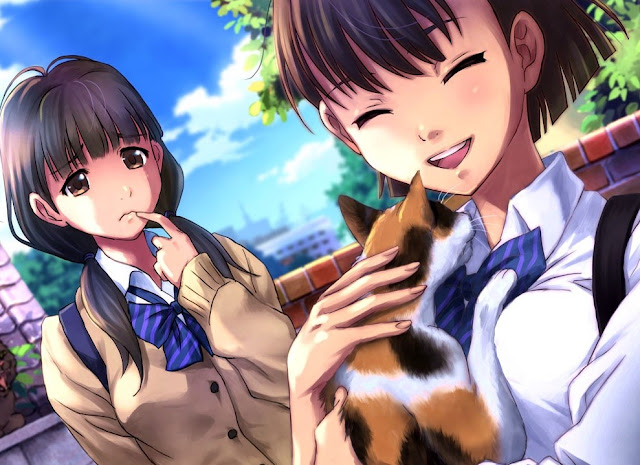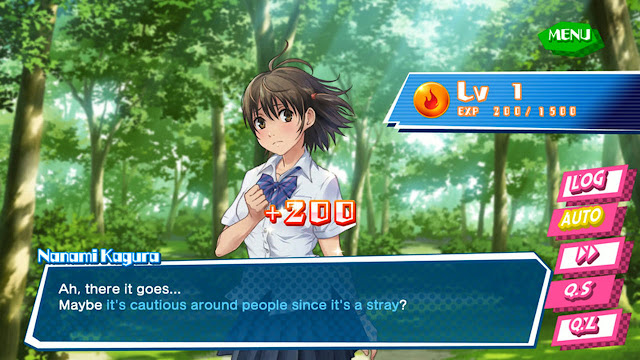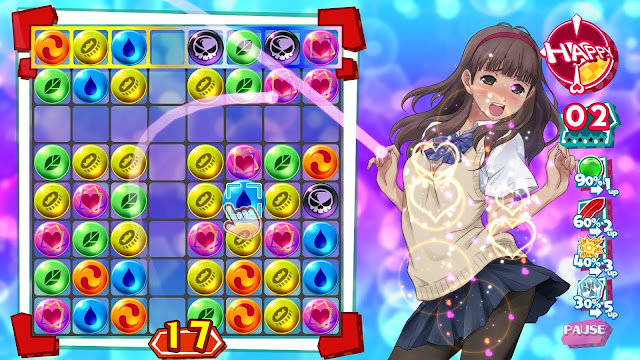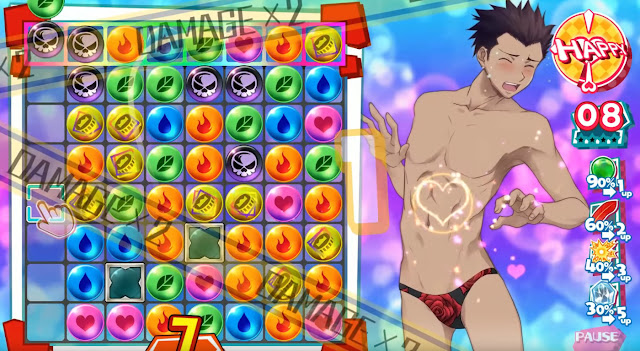Review by Matt S.
In Kotodama: The 7 Mysteries of Fujisawa you use your incredible powers of match-3 puzzling to strip a bunch of guys and girls down to their underwear. If that doesn’t sell you on the game, nothing will. Seriously. If seeing anime characters in amusing states of undress doesn’t fit within your sphere of entertainment, then you’re probably going to struggle with Kotodama. If it does, then you’re in for a rocking good time here, because among the other qualities of this visual novel, these characters have a truly sublime taste in lingerie.
Luckily I do rather like my fan service, and I really enjoyed what Kotodama has offered. PQube’s first foray away from pure game localisation and publishing to actual game development is broadly successful. It’s also perfectly in keeping in line with what you’d expect from the publisher that brought us Gal*Gun and Song of Memories.
In Kotodama you play as a guy (or girl) who has formed a bond with a cat-like demon-thing. That monster can only be seen by the protagonist, and it gives them the ability to coerce the truth out of other people. To do that, our hero “dives” into the unconscious mind of their victim, and slowly strips away the layers of clothing of that person as they appear in the protagonist’s mind, which parallel the layers of deceit that the target has put up in their real-world conversations. Those layers of deceit being visually represented by clothes, see? The stripping is thematically relevant, and at the same time morally justified, as you’re only fantasising about ripping their clothes off! Once they’ve successfully brought a person to nakedness, the protagonist is thrown back to the real world, at which point their target does indeed behave like they’ve been injected by some powerful truth serum and spills all the beans.
The reason why the protagonist is jumping from one mind to the next to rip clothes off people in the name of truth is because it’s the only way to solve some pressing mysteries going on in the real world. Fujisawa Academy is a school that is famous for having seven urban legends that all seem to be actually happening. The protagonist is a new transfer to this school, and finds him- or herself joining a small club that is dedicated to investigating and solving these mysteries. The urban legends are pretty amazing bunch, too, so you can understand the appeal of investigating them. There’s a great wolf, a ghostly presence stalking the school at night, and a special library where people go in and come out as knowledgeable geniuses. That’s just the first three of the seven of them, each more wild than the next.
Urban legends don’t just materialise out of thin air, though. With all urban legends there’s a seed of truth buried within the fantasy. As Peter Watts writes in his novel, Maelstrom: “Rumors had their own classic epidemiology. Each started with a single germinating event. Information spread from that point, mutating and interbreeding—a conical mass of threads, expanding into the future from the apex of their common birthplace. Eventually, of course, they’d wither and die; the cone would simply dissipate at its wide end, its permutations senescent and exhausted.”
Furthermore, as another novelist, Thomm Quackenbush, writes in his novel, We Shadows, the seed that urban legends springs from often comes from a place of tragedy, hence why so many urban legends are so closely related to things that horrify or terrify us. “The seed of an urban legend find fertile soil at the corner of tragedy and imagination,” Quackenbush writes.
Kotodama: The 7 Mysteries of Fujisawa is an exploration of this idea that urban legends have roots in real-world events and people. Each of the academy’s urban legends are rooted somehow in some kind of tragic event that has happened to one character or another… and that has subsequently caused them to become part of the urban legend’s apparent reality around the campus. I don’t want to give away many of them, because half of the impact of Kotodama as a narrative comes from seeing the truth come out and the mystery being solved, but I’ll use the first of the seven stories as an example:
The investigation crew are looking into the legend of the wolf around school. They track the story down to its roots in a small forest just outside of the school, where they meet a girl who is well known to hold a deep love for animals. Unfortunately, for reasons, she’s also physically abusing those animals, causing one in particular – a great white dog – to scramble to get out of the way whenever she’s around. Hence the resulting urban legend of the wolf, as other people see this fleeing dog for the briefest second out of the corner of their eye.
And, as noted above, the only way to get to the bottom of this is to dive into this abusive girl’s unconscious mind, strip her “inner self” down, and then get her to confess to what she’s doing back in reality. It’s like one very kinky version of Phoenix Wright.
The above story is pretty shocking and affecting for a game that looks like it’s all about bright colours and silk panties, right? Kotodama does have its moments when it hits on some pretty heavy themes, and the generally bright and cheerfully fanservicey aesthetics and tone behind the game make the impact of those moments all the sharper. Not each mystery ends in something as sharp as the first one, though, and if I was disappointed with anything within Kotodama’s storytelling, it’s that the writers were unwilling to go to the same thematic extremes that its opening chapter promised. There was real potential for this game to generate some interesting discussions, and at first I thought it was indeed going to travel down a direction similar to Death Mark with its very adult, very sadistic undertones, only this time under the guise of almost garishly bright colours. Sadly, PQube opted out of playing chicken with people’s tolerances for truly extreme themes, and while it pushes the boundaries a couple of times, ultimately this game does play it safe with its themes.
Still, as a piece of entertainment, Kotodama is a joyful ride. Aesthetically it’s a stunning game. As a visual novel, the quality of the environment and character art is paramount, and I’m happy to report that each of the environments evoke a sense of comfortable genre tradition, executed to precision. Meanwhile, it’s in the character art that this game really demands attention. Secondary characters that pop up through the narrative are all drawn quite simply, but the main boys and girls – the ones you’ll be playing match-3 striptease with – are absolutely gorgeous examples of anime character art. Each character’s personality is reflected perfectly through their design, and I’d go as far as to say I’ve enjoyed these designs as much as I have the work of any of the other fan service anime genre’s greats, including the legendary Tsunako and Mel Kishida.
The puzzle action is also well-executed. There’s a slightly different perspective in play compared to most match-3 puzzlers where, rather than moving blocks around or making them disappear, in Kotodama when you select an icon, it jumps to the top of the play field and all the icons below it drop down to fill the space. It’s just enough to make match-3 veterans like myself look at the match-3 playfield a little differently, without breaking too far from the standard expectations of this kind of puzzle game. The perfect balance, in other words.
There’s no time limit to the puzzles, but it’s by clearing away enough icons within a turn limit that you’re able to remove layers of clothing from the characters, which is amusing enough the first couple of times, but quickly reveals Kotodama’s one weakness as a game; there’s very little replay value to the match-3 side of things. A good match-3 generally has some kind of score or leaderboard system… and ideally an endless mode. I’ve put dozens of hours of play into the Nameko match-3 puzzler on Switch because, simple as it is, it does offer that endless challenge of trying to get yourself a better score.
Seeing your favourite character in different undies is the only reason to replay Kotodama’s match-3 game. Each character has three alternate sets of panties or boxers for you to unlock through play. It’s great fun seeing what Yukino looks like in different lacies, don’t get me wrong, but once I’d played through her puzzle board a few times, I had seen her entire wardrobe, and there was no further incentive to keep playing on. The game does track the fastest time that puzzles are completed, both on “normal” and “hard” difficulty settings, but it would have been nice to have extended that to a proper leaderboard, just to give people a chance to prove who’s the fastest at stripping. This could have been the game that finally got me on board with esports.
While I’m being critical, within the visual novel, there’s also a number of gamey elements that I find too arbitrary. For example, you can “level up” the strength of the icons by hearing specific phrases in conversations, but given how little room there is to miss dialogue, and how easy the puzzles are to complete regardless of your “level”, that system comes across as entirely pointless.
Chalk these up as teething issues for a first-time game developer. None of them impact on the overall quality of the game anyway, and while the match-3 minigame might not me the most replayable example of the genre, it’s still enjoyable and well-executed, and being backed by a full-length visual novel still means you’ll be spending plenty of time in Kotodama. So really, my biggest issue with the game is that PQube didn’t hit us up to use the DigitallyDownloaded.net mascot, Dee Dee, as an unlockable/ bonus character in the game. She would be clearly perfect for a role within this group.
I enjoyed Kotodama a great deal. It’s just surprising enough to keep the narrative interesting, and the colourful humour and cheerful fan service certainly help make the game a delight to play. Could it have been more? Yes, certainly. There are plenty of moments in Kotodama that you’ll think to yourself that it could have been much more than a straightforward fanservicey romp… but the developers have achieved exactly what they set out to do, and have done so with such precision and panache that it’s a real joy to play anyway.
– Matt S.
Editor-in-Chief
Find me on Twitter: @digitallydownld
Please help keep DDNet running: Running an online publication isn’t cheap, and it’s highly time consuming. Please help me keep the site running and providing interviews, reviews, and features like this by supporting me on Patreon. Even $1/ month would be a hugely appreciated vote of confidence in the kind of work we’re doing. Please click here to be taken to my Patreon, and thank you for reading and your support!













